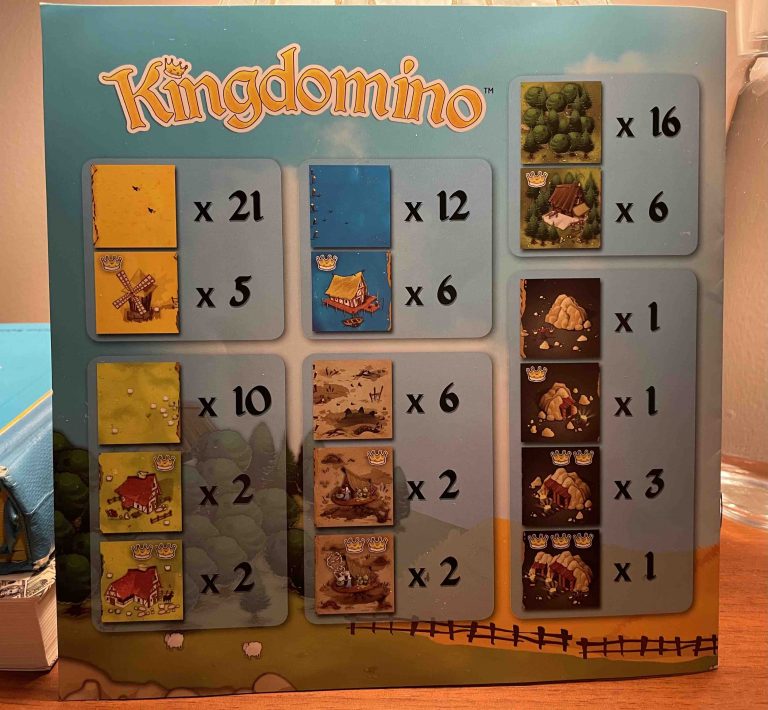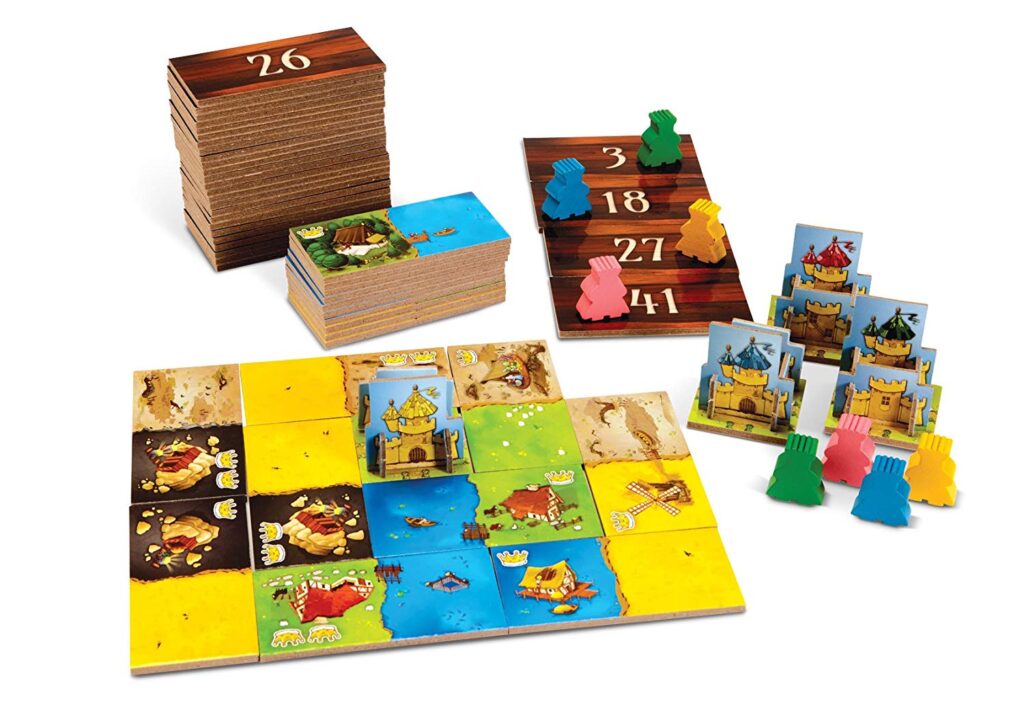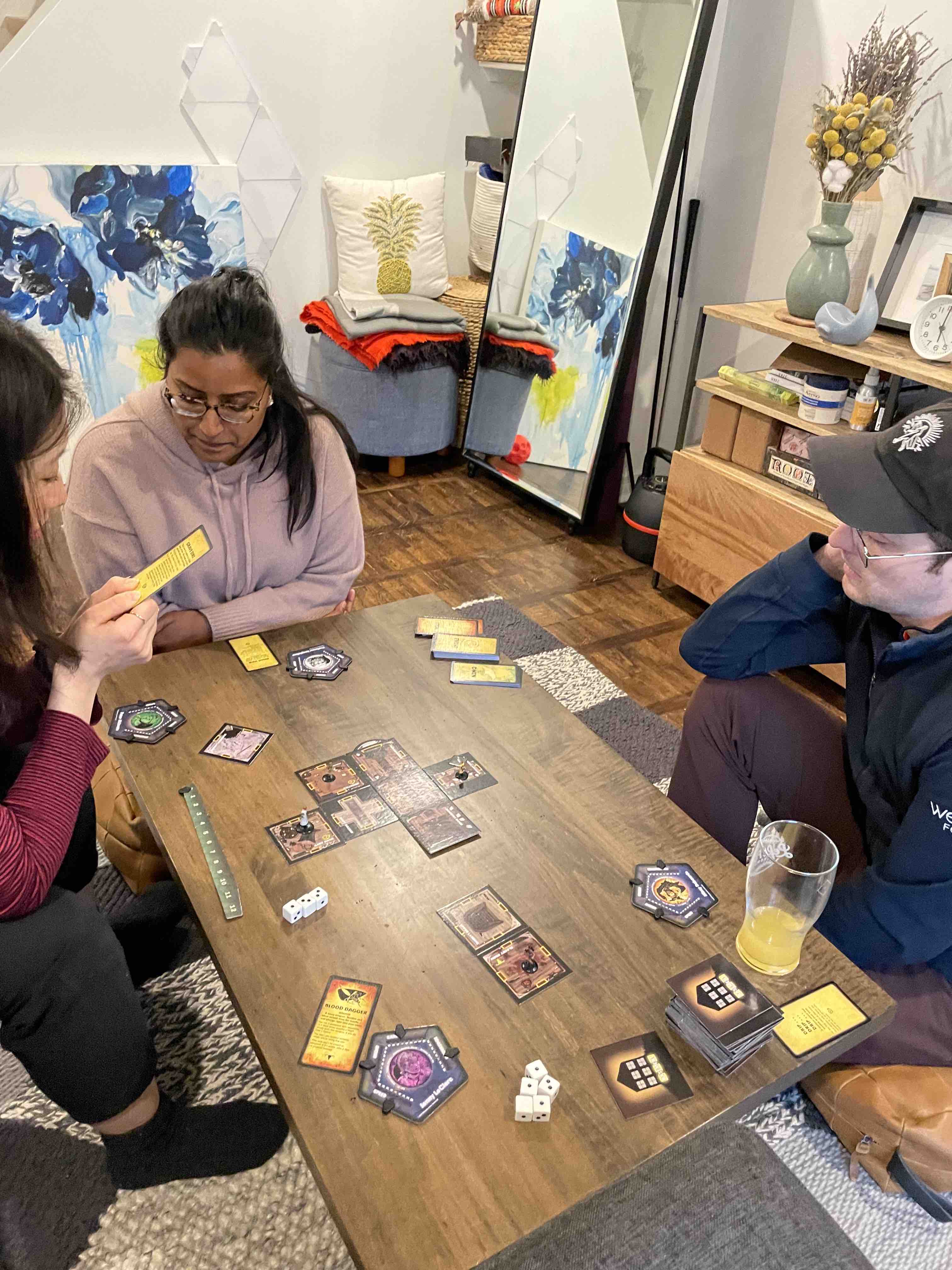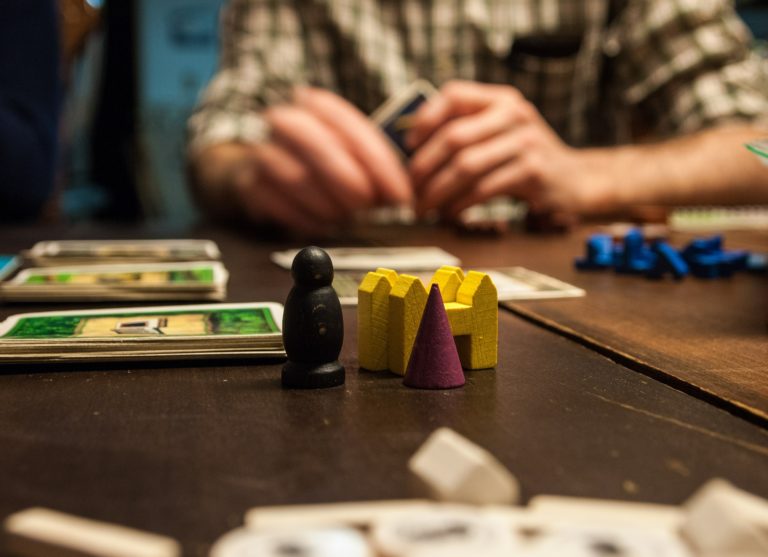When it comes to well-kept secrets, the board game Kingdomino takes the cake! It’s such a simple, yet highly addictive board game that’s both competitive and quick to play.
And, for it’s surprisingly low cost, just oozes with value.
The objective of Kingdomino is to gather and build the most lucrative 5 x 5 square kingdom around your castle using domino tiles, earning you points based on the number of connected terrain territories.
So, what’s included in the Kingdomino board game box? Well, the contents are as following:
- 48 high quality domino tiles
- 4 colored starting tiles
- 4 3D colored castles (assembly required)
- 8 colored “king” player meeples
- 1 printed set of instructions
CAUTION: Because this board game contains a few pieces that are choking hazards, the suggested age for playing is 8 years old and up.
Setting up a game of Kingdomino is simple, and only takes a few minutes.
To setup the board game:
- Each player assembles their colored 3D castle and places on their respective colored starting tile in front of them.
- Each player takes their respective colored king meeple.
- Note: For 3 and 4 player games, only one meeple is required, however for 2 player games both meeples are required.
- Randomly shuffle all the domino tiles and place them in the box. Make sure both sides (terrain and number) are not visible.
And now you’re ready to play – It’s just that easy!
The rules for Kingdomino are fairly straightforward and simple. However, there a few important details you need to know when playing this board game.
The complete rules for Kingdomino can be found here.
Drawing and Selecting Tiles
To start, remove 4 tiles from the box and place them terrain-side down. On the back-side of each tile is a number. Since there are 48 tiles, each tile is number 1 through 48.
Arrange the 4 tiles from smallest (top) to largest (bottom) in a row. Then, flip each tile to reveal the terrain side.
Whoever is selected to go first takes their king meeple and places on the tile they want. Clockwise from the first person, players place their king meeple one of the remaining tiles.
Player Turns
Once all four players place their king meeple, 4 new tiles are drawn from the box, placed terrain side down, arranged smallest to largest, and flipped over.
From top (smallest) to bottom (largest), players remove their meeple, take and place that tile around their starting tile, and then place their meeple on the next set of revealed tiles.
Player order is dictated by the order of king meeples on the tiles – smallest always goes first!
Once all players have placed their tiles on their kingdom and moved their king meeple onto the new set of tiles, 4 more tiles are then selected and the process is repeated.
Domino Tile Information
Each domino tile is comprised of two terrain squares (2×1). In total there are 6 types of terrain which include farm, forest, grassland, mine, sea, and swamp.
Some terrain squares contain crowns. These crowns represent “multipliers” for connected terrain of the same type. (More about crowns below).
As mentioned, each tile is also numbered 1 to 48. The higher the number, the more valuable the terrain. But, if you select a high value tile, you’re left picking last for the next round, so it’s about finding a good balance.
Terrain Rules
When placing a tile on your kingdom, at least one terrain square must match if it’s connecting to a tile already placed on your kingdom.
Now, this rule does not apply when placing tiles on the starting tile, which can be considered a universal terrain.
Connected terrain squares create a territory. But, territories are only valid if the terrain is connected horizontally or vertically. Diagonally connected terrain do not count as connected.
Additionally, your kingdom is limited to a 5 x 5 square, which includes the starting tile. Your kingdom can also have gaps, whether intentional or not.
If you cannot find a suitable spot to place a tile on your kingdom, whether the terrain cannot match or you’ve extended beyond the 5 x 5 limit, you must discard the tile.
End of Game & Scoring
Once all the domino tiles are drawn and played, the game ends and the scores are calculated.
For every terrain territory, count the number of squares and multiple by the total number of crowns in that territory. Territories without crowns score no points. A single terrain square, not connected to other terrain but containing a crown counts as an individual territory.
Players then add up their individual territory points to determine their final score. The player with the highest scoring kingdom wins!
2 Player Games
If there are only two players, each player uses both king meeples. Only 24 (or half) of the domino tiles are required.
For the first round, players take turns selecting their tiles. For subsequent rounds, the order of selection is dictated by the order of king meeples on the tiles.
3 Player Games
For 3 player games, all 48 tiles are used, however during tile selection, the domino that is not selected is discarded.
The Mighty Duel (2 Player Only)
Use all 48 dominos and create a 7×7 kingdom!
“Harmony” Bonus
Players earn a bonus 5 points if their kingdom forms a complete 5×5 (or 7×7) grid with no gaps.
“Middle Kingdom” Bonus
Dynasty Game
For the extra competitive, players can opt to play 3 games in a row. The player with the most total points wins.
Kingdomino is so much fun because the board game dynamics are very simple to understand.
But, the fact that you can only see and select one tile ahead makes planning difficult. A terrain plan you might start out pursuing might morph into something else as the game plays out.
Another important aspect to understand about Kingdomino is that not all terrain types are created equal.
- There are not the same amount of terrain squares and crowns available for each terrain type.
Take a look at the terrain square breakdown in the image below.

My Strategy
Kingdomino is a great board game because it simultaneously rewards and punishes you for your domino selection.
- By picking a “higher value” domino, you are risking picking your next tile last.
- Alternatively, by picking the lowest value domino, you are guaranteed to pick the next set of tiles first, which is to your benefit.
Personally, I tend to only select the highest value (bottom) domino tiles once I start to establish distinct territories.
I also try my best to layout my kingdom such that I have the flexibility to add pretty much any tile that I have selected without breaking the terrain placement or 5 x 5 rule.
Pro-tip: Pay close attention to what the other players are vying for and either sabotage their efforts by selecting domino tiles they would want or go for tiles they don’t want or need.
Do you enjoying playing Kingdomino? What board game variations do you like playing? Let me know in the comments below!
This article contains affiliate links, which help support this blog at no cost to you!





